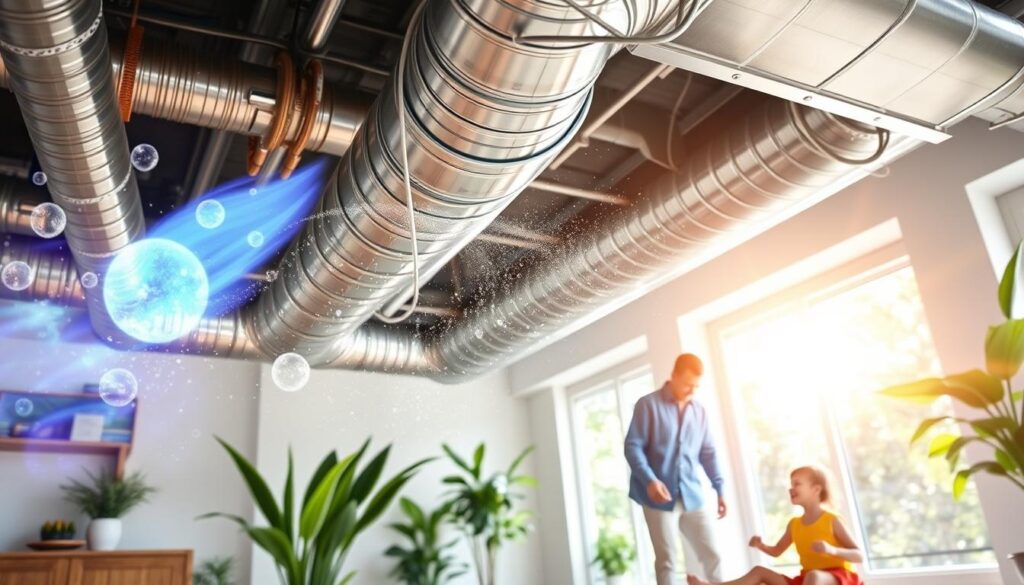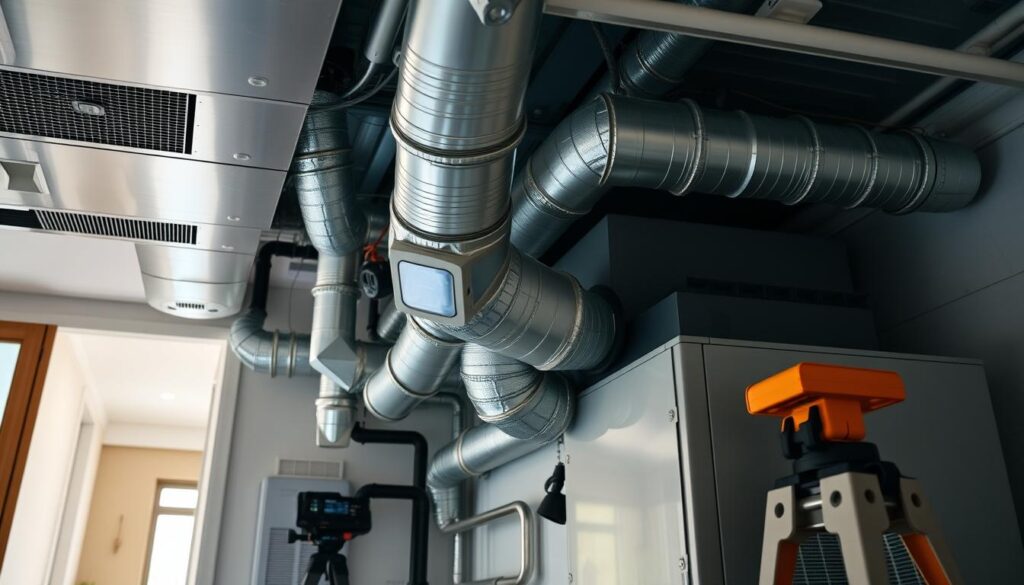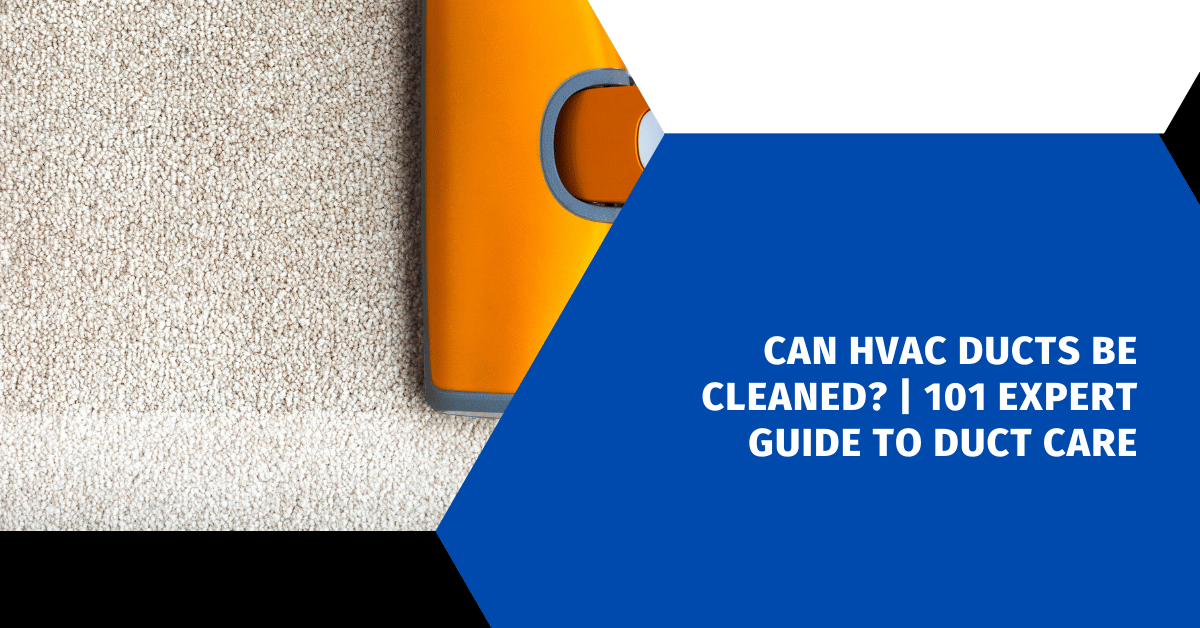Can HVAC Ducts Be Cleaned? As the sun sets on a chilly autumn evening, Sarah notices a peculiar musty odor wafting through the vents of her cozy home. Concerned about the air quality, she remembers a recent conversation with her neighbor about the importance of regular HVAC duct cleaning. Intrigued, Sarah decides to delve deeper into the world of air duct maintenance and discover if her home’s ventilation system could benefit from a thorough cleaning.
HVAC duct cleaning is a complex and often misunderstood topic, with varying opinions on its necessity and effectiveness. While the Environmental Protection Agency (EPA) does not routinely recommend duct cleaning, it acknowledges that it may be necessary in certain situations to improve indoor air quality and system efficiency. The process typically involves cleaning various components of a forced air system, including supply and return air ducts, registers, grilles, heat exchangers, and cooling coils.
As Sarah learns more, she discovers that the cost of professional duct cleaning can range from $450 to $1,000 per system, depending on factors like the size of the home, the complexity of the ductwork, and the level of contamination. While proper cleaning can potentially enhance system performance and indoor air quality, the necessity of this service should be evaluated on a case-by-case basis, often with guidance from reputable HVAC technicians.

Key Takeaways
- Regular HVAC duct cleaning is recommended, typically every 3-5 years, according to the National Air Duct Cleaners Association (NADCA).
- Professional cleaners have specialized equipment and expertise to remove more dust and debris than DIY methods.
- Mold in air ducts can pose serious health risks and should be handled by professionals.
- Regularly changing air filters helps maintain good indoor air quality.
- Hiring a professional for air duct cleaning is beneficial due to their specialized equipment and expertise.
Table of Contents
Understanding HVAC Duct Cleaning Basics
Keeping your home’s HVAC system clean is key for good air quality and efficiency. Cleaning the HVAC system means more than just the air ducts. It also includes important parts like coils, drain pans, and air plenum.
What Components Need Cleaning
The National Air Duct Cleaners Association (NADCA) says these parts need regular cleaning:
- Air ducts
- Coils
- Drain pan
- Registers and grills
- Air plenum
- Blower motor and assembly
- Heat exchanger
- Air filter
Cleaning these parts well helps get rid of dust and dirt. This stops them from spreading through your home up to 5-7 times a day. This can harm your indoor air quality.
Professional vs DIY Approaches
While DIY duct cleaning might save money, it’s best to get a pro. Professionals use special tools like truck-mounted vacuums. They also follow strict cleaning standards to ensure a safe and thorough job.
Cost Considerations for Duct Cleaning
Professional duct cleaning costs can be between $450 and $1,000. This depends on your home’s size, duct access, and how dirty they are. Even though it’s a big expense, it’s worth it for better air quality, a longer HVAC life, and saving energy.
“A thorough duct cleaning should typically take around three to five hours for completion, according to the National Air Duct Cleaners Association (NADCA).”
Explore Our HVAC Shop
Looking for top-rated HVAC tools, parts, and accessories? Visit our shop and find the perfect solution for your needs.
Visit the ShopSigns Your Air Ducts Need Professional Cleaning
Keeping your home’s air clean is key for your family’s health and comfort. But, often, we forget about the cleanliness of our HVAC ducts. Here are some signs that your air ducts might need a pro’s touch:
- Visible mold or mildew on your ductwork or HVAC parts.
- Signs of pests like rodents or insects in the ducts.
- Too much dust and debris in the ducts or coming out of the vents.
Not all stuff that looks like mold is actually mold. You might need a pro to test it. If you see any of these signs, fixing the problem is key before or with cleaning to stop it from coming back.
Other signs your air ducts might need a clean include:
- Filters getting clogged all the time and needing to be replaced often.
- Bad smells coming from the ducts.
- Uneven airflow in your home.
- Higher bills for heating and cooling.
- Strange noises from the ductwork.
Cleaning your ducts every 3-5 years helps keep the air in your home clean and your HVAC system running well. Catching these signs early means a healthier, more comfy home for your family.
“The Environmental Protection Agency (EPA) says Americans spend about 90 percent of their time indoors. Indoor pollutant levels can be 2 to 5 times higher than outside.”
Can HVAC Ducts Be Cleaned? The Expert Answer
Yes, HVAC ducts can be cleaned. But it’s more than just cleaning the ducts. Cleaning techniques can greatly improve your home’s air quality and efficiency.
Common Cleaning Methods
Professionals use several methods to clean ducts. They use tools like brushes and air whips to loosen dirt. Then, they vacuum with powerful machines to get rid of it all.
Equipment Used in Professional Cleaning
Experts use special tools for duct cleaning. They have vacuums, brushes, and other gadgets to get into every part of the ducts. They also use machines with filters to keep the air clean while they work.
Duration and Process Overview
How long it takes to clean ducts depends on the system’s size and how dirty it is. It can take a few hours to a whole day. The whole HVAC system is put under negative pressure to keep dirt from spreading.
Homeowners can do some maintenance, like changing air filters. But, professional duct cleaning is needed for the parts you can’t reach. Clean ducts mean better air, more efficient systems, and lower energy bills.
Explore Our HVAC Shop
Looking for top-rated HVAC tools, parts, and accessories? Visit our shop and find the perfect solution for your needs.
Visit the ShopHealth Benefits and Indoor Air Quality Impact
Clean air ducts can greatly improve your indoor air quality and health. While duct cleaning can’t solve all air pollution problems, it helps reduce harmful particles. These particles can harm your breathing.
The American Lung Association says indoor air is often more polluted than outdoor air. We spend most of our time inside, so this is a big concern. Cleaning your HVAC ducts regularly can help make your home air cleaner and healthier.
Duct cleaning can cut down on allergens like pet dander and pollen. This is good news for people with allergies or asthma. It can lead to better sleep and breathing, and overall health improvement. Cleaning your air ducts can also lower the chance of getting sick, making it a smart choice for your family’s health.
Clean ducts also make your heating and cooling system work better. Dust and debris in the ducts can block airflow and lower system performance. EnergyStar says airflow issues can cut an HVAC system’s efficiency by up to 15%. Regular cleaning can improve airflow, save energy, and extend your HVAC’s life.
Deciding to clean your air ducts should be thought out. But the health and efficiency gains are worth considering. Professional duct cleaning services can keep your HVAC system running well. This promotes a healthier home and might save you money on energy costs in the long run.

“Dirty ductwork can cause air filters to clog faster, requiring them to be replaced more frequently, impacting maintenance costs.”
Professional Cleaning Techniques and Tools
Keeping your home’s air ducts clean is key for better air quality and HVAC system efficiency. Professional duct cleaning uses special techniques and tools to remove dirt and debris. Let’s look at what makes a duct cleaning process complete.
Source Removal Methods
Duct cleaning pros use different methods to get rid of dirt and contaminants. They might use drills and screwdrivers to open ducts for a deep clean. They also use cameras to check the ducts before cleaning.
Negative Pressure Systems
Negative pressure systems are a big part of duct cleaning. These powerful vacuums keep debris out of your home while cleaning. Sometimes, portable vacuums are used when big machines can’t fit.
Specialized Equipment Types
Duct cleaning experts use many tools for a thorough clean. They use brushes and air compressors to clean stuck-on dust. The National Air Duct Cleaners Association sets standards for using these tools right.
With these techniques and tools, duct cleaners can improve your air quality and HVAC system’s life. Regular duct cleaning makes your home healthier and more comfortable.
Chemical Treatments and Biocides in Duct Cleaning
Chemical treatments and biocides in duct cleaning are often debated. Some services offer these, saying they kill germs and stop them from coming back. But, how well they work and if they’re safe is still a mystery.
HVAC biocides, duct sealants, and antimicrobial treatments are marketed to fight air duct contamination. But the reality is more complex. The Environmental Protection Agency (EPA) hasn’t approved any chemical biocides for air ducts. This lack of approval raises questions about their safety and effectiveness.
Thinking about chemical treatments? It’s important to weigh the risks and benefits carefully. These should only be used after the ducts are thoroughly cleaned. Using them too soon or wrong can trap bad stuff or release harmful gases into your home.
“The EPA does not recommend routine use of sealants to encapsulate contaminants in ducts, highlighting concerns about their safety, effectiveness, and durability over time.”
To keep your air clean, stick to proven methods. This includes regular duct cleaning, keeping your HVAC in good shape, and making sure your home breathes well. Chemical treatments should be used with caution and only when you fully understand their effects.
Deciding on HVAC biocides, duct sealants, or antimicrobial treatments should be a team effort. Talk to a trusted duct cleaning expert. They can help choose the best option for your system, keeping your air and HVAC system healthy in the long run.
Explore Our HVAC Shop
Looking for top-rated HVAC tools, parts, and accessories? Visit our shop and find the perfect solution for your needs.
Visit the ShopPreventing Future Duct Contamination
Keeping your HVAC system clean and working well is key for good indoor air. It also stops duct contamination from happening again. By taking a few easy steps, you can keep your home and family safe.
Regular Maintenance Tips
Regular HVAC care stops duct contamination. Here are some important steps to take:
- Change air filters every 1-3 months to keep your system efficient and dust-free.
- Keep your home clean to reduce dust and contaminants that can get into your HVAC system.
- Fix any moisture problems fast to stop mold in your ductwork.
- Get your HVAC system checked and tuned up every year to make sure it’s working right.
Filter Replacement Guidelines
How often to replace air filters depends on the filter type and your home’s use. Here’s a general rule:
| Filter Type | Replacement Frequency |
|---|---|
| Standard Filters | Every 1-3 months |
| High-Efficiency Filters | Every 6-12 months |
Always check your filters and replace them as needed. This keeps your HVAC system running smoothly and stops contaminants in your ductwork.
“Proper HVAC maintenance, including regular air filter replacement, is essential for maintaining indoor air quality and preventing duct contamination.”
When to Avoid Duct Cleaning
Regular HVAC duct cleaning can make your air cleaner and your system work better. But, there are times when unnecessary duct cleaning is not needed. If no one in your home has allergies or illnesses, and your ducts look clean, you might not need to clean them.
The Environmental Protection Agency (EPA) doesn’t suggest routine duct cleaning for everyone. Before you decide to clean your ducts, get a pro to check your HVAC system and air quality. This will tell you if cleaning is really needed or if other steps are better for your air.
“An estimated $60 billion is lost in productivity due to poor IAQ.”
Light dust on return registers is normal and doesn’t mean you need to clean your ducts. In fact, unnecessary duct cleaning can sometimes make things worse. It can stir up dust and make your air worse.

If you’re thinking about duct cleaning, do your homework first. Don’t clean flexible “Wireflex” ducting because it can get damaged. Also, some say newer, stronger equipment can handle debris without cleaning.
Deciding to clean your ducts should be based on a detailed check of your air and HVAC system. Knowing when duct cleaning is really needed helps keep your air and system healthy.
Conclusion
Deciding to clean your HVAC ducts depends on your home’s needs. Professional duct cleaning might improve efficiency and air quality. But, it’s not always a must or a sure win.
Regular maintenance and good air filters are often better for air quality. They can keep your air clean without duct cleaning.
If duct cleaning is needed, pick a qualified pro. They should follow NADCA standards. They’ll check your system and suggest the best cleaning methods.
Don’t use chemical treatments unless really needed. They can be risky.
Your HVAC care, duct cleaning quality, and air quality efforts matter. Working with experts helps make your home healthier and more comfortable. Stay informed and choose trusted professionals for the best results.

